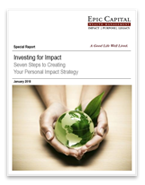ABLE Accounts for Loved Ones with Disabilities
Feb 5, 2020
Families with special needs children have a new tax-deferred savings option.
The ABLE account, also called a 529A savings account, is patterned after the popular 529 savings plan, created to help parents save for a child’s higher education. Like 529 plans, ABLE accounts are run by states rather than the federal government. These plans emerged after the passage of the Achieving a Better Life Experience (ABLE) Act in 2014.1
ABLE accounts address an underpublicized financial need.
While some families open college savings accounts, comparatively few start discrete savings accounts or trusts for children with disabilities. That difference may be partly due to the presumption that “the money will be there” when the child becomes an adult.
The money may not be there; at least, not as much of it as many families hope. State agencies and nonprofit groups helping the disabled face ongoing funding challenges, including pressure to limit the “entitlements” they distribute. Social Security, which provides Supplemental Security Income (SSI) to millions of disabled adults, faces its own set of issues.
Financially and legally, what changes when a child with special needs turns 18?
As an adult, a disabled person becomes eligible for Medicaid and monthly SSI payments, provided they meet the financial requirements, typically only available to those with $2,000 or less in assets. Some special needs adults have more than $2,000 in assets in their name by age 18. Savings accumulate, family gifts and investments are made on behalf of the child, and suddenly, that young person is ineligible for fundamental health care and income benefits.2
ABLE accounts nicely address this dilemma.
Money accumulated in a tax-advantaged ABLE account does not count toward that $2,000 total. Even if funds in the account exceed $100,000, the account beneficiary will still be eligible for Medicaid (albeit, ineligible for SSI).1
How large can an ABLE account become?
Current ABLE account maximums range from $235,000 to $529,000 (limits vary per state). Account contributions can be made by anyone.1,3
What if the state you live in has no ABLE accounts?
Consider opening an account in another state. Some states allow out-of-state residents to participate in their ABLE programs. (It is also worth noting that some states have lower account fees than other states.)1,3
ABLE account holders have some new options, thanks to federal tax reform.
The Tax Cuts and Jobs Act of 2017 brought notable changes for these accounts. While the basic annual account contribution limit is currently $15,000 for an individual, working ABLE account holders may now contribute employment income to their accounts in excess of that $15,000 threshold, up to the individual federal poverty level set for the preceding calendar year. In addition, some account beneficiaries may be eligible for the Saver’s Credit, a sizable federal tax break.1
You may now roll over up to $15,000 from a standard 529 plan into an ABLE account. One key condition must be met: the beneficiary of the standard 529 plan must either be the same person who is the beneficiary of the ABLE account or a member of the same family as the ABLE account holder.1
ABLE accounts are becoming an important component of special needs planning.
The word worth emphasizing here is “component.” The money in an ABLE account alone may not be enough to cover lifetime care expenses for a disabled adult, even if the account is replenished. An ABLE account is usually not a financial “answer” for families with mentally or physically challenged children, but a part of a greater financial strategy that might include a supplemental needs trust or other savings vehicles.
These accounts do have their shortcomings.
The biggest drawback of ABLE accounts is that they do nothing for people who become disabled after age 26. You cannot open one for someone older than 26, unless the individual became disabled prior to reaching that age. Another little-known demerit: states sponsoring accounts can seek repayment from those accounts for the cost of care covered by Medicaid if the beneficiary dies.1,3
Account contributions are not tax-deductible at the federal level (some states do permit deductions). This tradeoff is made in exchange for tax-deferred earnings and tax-free withdrawals. Withdrawals go untaxed, so long as the money is spent on “qualified disability expenses,” which can range from education, housing, and transportation costs to job training and health care. Nonqualified withdrawals, naturally, are taxable.1
The bottom line?
ABLE accounts give families with children who have special needs a new way to save and invest for future needs and expenses.
Tags: Disability, Disability Insurance, Family Wealth, Health and Wellness, Health Care Needs, Health Care Savings, Long-Term Care Planning, Personal Finance, Tax Advantages, Wealth Building
More Insights
Key Takeaways Volatility came back with a vengeance this week as selling pressure in the mega cap space dragged down the broader market. Counterbalancing weakness in these heavyweight names poses a challenge for the rest of the market. Overbought conditions can also be blamed for the recent weakness. The S&P 500 reached a 14.9% premium … Continue reading “Market Update – Assessing the Technical Damange”
Life insurance can be an excellent tool for charitable giving. Not only does life insurance allow you to make a substantial gift to charity at relatively little cost to you, but you may also benefit from tax rules that apply to gifts of life insurance.
When you think of Social Security, you probably think of retirement. However, Social Security can also provide much-needed income to your family members when you die, making their financial lives easier. Your family members may be eligible to receive survivor benefits if you worked, paid Social Security taxes, and earned enough work credits. The number … Continue reading “Social Security Survivor Benefits”
Information vs. instinct. When it comes to investment choices, many people believe they have a “knack” for choosing good investments. But what exactly is that “knack” based on? The fact is, the choices we make with our assets can be strongly influenced by factors, many of them emotional, that we may not even be aware … Continue reading “Making Investment Choices”
As a business owner, you should carefully consider the advantages of establishing an employer-sponsored retirement plan. Generally, you’re allowed certain tax benefits for establishing an employer-sponsored retirement plan, including a tax credit for establishing the plan and a deduction for contributions you make. In return, however, you’re required to include certain employees in the plan, … Continue reading “Retirement Plans for Small Businesses”
Services
Epic Capital provides the following comprehensive financial planning and investment management services: Learn More >


 Top of Page
Top of Page











